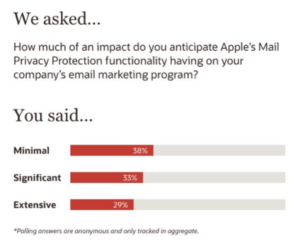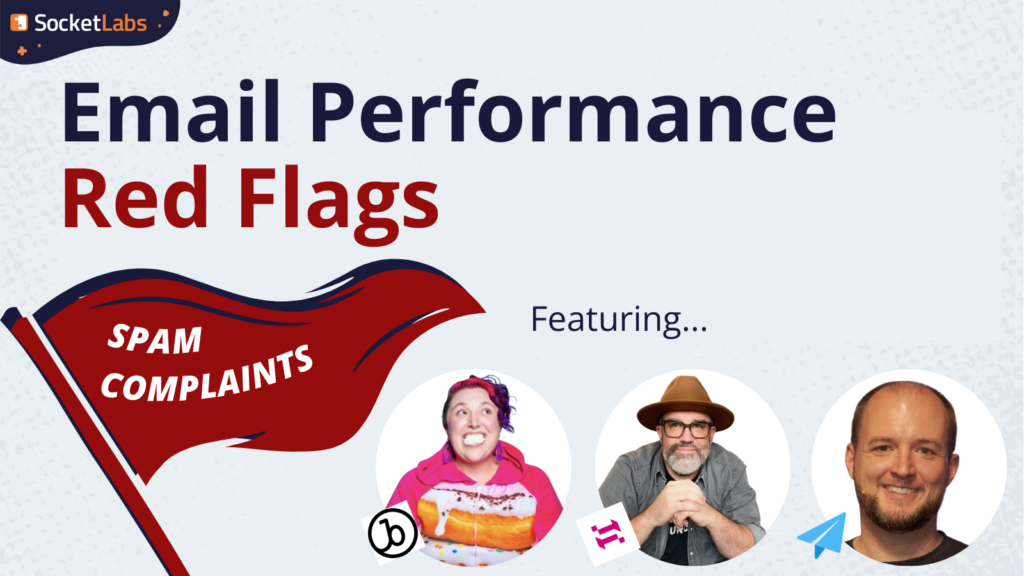Navigating Apple’s changes to privacy controls, which are (further) killing the accuracy of your open rates.
Email open rates have historically been one of the most closely monitored benchmarks in email performance. Some of the most common questions we get from senders are 1) why are my email open rates declining, and 2) what are some tips and tricks that will help me get a good email open rate. And while email open rates are important to an extent, they are certainly less important than senders seem to think, and they’re becoming even more obsolete with new policies and regulations coming from major operating systems in the coming days.
Why Email Open Rates are Becoming Untrackable
Back in June, Apple announced Mail Privacy Protection (MPP) would be included in their upcoming iOS 15 release, affecting their Mail app on the iPadOS 15, macOS Monterey, and watchOS 8 devices.
According to Apple:
“Mail Privacy Protection stops senders from using invisible pixels to collect information about the user. [It prevents] senders from knowing when they open an email, and masks their IP address so it can’t be linked to other online activity or used to determine their location.”
So what does this mean in the actual iOS 15 update? Here are a couple of the attributes that will be masked, or kept private:
- Recipient’s connection IPs (which will, among other things, mask location)
- Email open activities
- Tracking pixels
- The type of Apple device used
And now, the release that email marketers have been scrambling to prepare for is officially upon us. Yesterday’s Apple announcement advised that iOS 15 would be hitting the streets on September 20th, 2021.
How Apple’s Mail Privacy Protection Update Affects You
We’ve already reported on the impacts MPP will have on email marketing, which are forcing quite a few marketers to update their business-as-usual practices when it comes to email performance monitoring. In a recent poll conducted by Oracle, approximately 62% of marketers said this would have a significant or extensive impact on their company’s email marketing program.  In some cases, this impact is due to marketers’ heavy use of email open rates as a proxy for measuring email success. Another contributing factor is the widespread usage of Apple iOS devices within many regions of the world. For reference, within the US, market share is around 56%, whereas in areas of the world like India, it’s only around 3%. List composition is very specific to the sender though, so do your research to understand how much of an impact MPP might have on your list.
In some cases, this impact is due to marketers’ heavy use of email open rates as a proxy for measuring email success. Another contributing factor is the widespread usage of Apple iOS devices within many regions of the world. For reference, within the US, market share is around 56%, whereas in areas of the world like India, it’s only around 3%. List composition is very specific to the sender though, so do your research to understand how much of an impact MPP might have on your list.
But while the impact of MPP feels large compared to prior technological and legislative developments within our industry, this change is not actually something you need to lose sleep about. Let’s get into a bunch of reasons why.
Why Email Open Rates Were Never That Important
We’d all love to believe that opens are only triggered when one of the recipients on our list actually opens an email, this couldn’t be farther from the truth.

Email opens are measured by embedding a transparent tracking pixel within the email. This tracking pixel is a tiny graphic with 1×1 dimensions, usually placed at the end of the email, so it’s not typically noticed by humans. But when a subscriber’s mailbox provider (such as Gmail, Hotmail, or Yahoo) loads the images in an email, the open-tracking pixel is also loaded, which logs an open for the subscriber.
And while this sounds good in theory, it’s not that great of a reporting system when new technologies, user settings, and restrictions are constantly skewing the feedback and returning highly inaccurate numbers.
Where Email Open Data Comes From and Why it’s Not Accurate
To understand why tracking pixels leave a lot of room for error in email open reports, we first have to look into how opens are actually being recorded.
Anti-spam filters
Some subscribers and organizations have strict spam filtering in place (potentially including multiple layers of filtering) in an effort to protect against malicious emails. These filters automatically load images (and sometimes click links as well) to ensure they’re safe before delivering them on to recipient inboxes. Even spam trap operators have been known to “carefully open” certain messages if they doubt their legitimacy. While helpful or anti-abuse efforts, all this monitoring activity results in misleading opens and clicks being logged.
Background / automatic image loads
Some mailbox providers are now pre-loading images without being prompted by a user action to give subscribers a better experience within their inboxes.
What some senders don’t realize is that mailbox providers including Gmail and Yahoo have already been doing this! Just not all the time, so it’s harder to spot it. Apple’s MPP will result in aggressive image loading, leading to an open being recorded for every single recipient who reads email on their iPhone, iPad or iWatch — whether they read it or not.
Autoresponders
This one is dependent on the way your service provider reports on opens, but you may see an open event counted when a recipient enables automatic replies such as out-of-office responses. This can throw off your reporting during periods such as holidays or over the summer when more people are away from their desks.
Recipients (humans)
As expected, some email open data actually comes from recipients opening the email. But as the previous points highlight, it’s very challenging if not impossible to get an accurate count of actual recipient opens.
The recipient open data can be further skewed through recipient settings where they can choose auto-load images regardless of an actual open, or choose to disable loaded images completely or use services like DuckDuckGo, which in both cases, block the pixel.
The Sender
Some of the inaccurate email open data you receive can be on you, the sender. The most common fault in email data being inaccurate is your email is too long. Gmail is known to clip emails that have a message size larger than 102KB, resulting in the full content being hidden behind a link with a message stating “[Message clipped] View entire message”. When this happens, the open pixel (which is usually at the bottom of an email) gets clipped as well, removing your ability to track open performance.
As you’re beginning to realize, opens have never actually been linked directly to real human interaction with emails. They are nothing more than a proxy metric based on technology designed to help measure real human engagement.
3 Reasons Why You Don’t Need Email Open Rates To Be Successful
Looking on the bright side, opens are just a small piece of the email data puzzle… and let me tell you, it’s a big frickin’ puzzle! Here are a few ways unreliable open rates won’t impact the way you track email performance.
If you’ve been doing email the right way, not much is changing
if you’ve built your list with permission, make it easy for recipients to unsubscribe when they wish, and pay attention to your other data signals (including clicks, unsubscribes, spam complaints, conversions), your deliverability will not suffer. And you should still pretty easily be able to tell which of your campaigns/offers are resonating with your audience (leading to those sweet, sweet conversions). Or you’ll notice high unsubscribe and complaint rates, low clicks or revenue targets that have been consistently missed – and you’ll quickly be able to spot the first signs of a problem.
Email is a data-rich channel
Open rates are just one of the signals marketers can use to gauge the interest of their email audience. It’s the tip of the iceberg, really. The truth is, some recipients are opening but not interested, and others are interested but heading straight to your website when there’s a sale – so the most important action (the conversion) took place, you simply weren’t able to track it. Attribution sucks that way.
Other metrics to track include clicks, conversions, revenue per email, spam complaints, unsubscribes, bounce details and unsubscribe reasons if you’re collecting them. Also consider progressive profiling to ask recipients what types of content and/or frequency they are interested in.
Our StreamScore™ monitors email performance for you
The right technology goes a long way. Sure, you can go to essentially any email service and track basic engagement metrics and trends, but if you’re looking to better understand your likelihood of hitting the inbox, a standard reporting dashboard isn’t going to cut it.
StreamScore is our proprietary email health score which factors in 25-30 different variables, including 1st party data (like clicks, opens, bounces and complaints) and 3rd-party data (such as Google Postmaster tools and Microsoft’s SNDS, blocklisting status and spam trap information).
The beauty of StreamScore is that all of this internal and external data gets computed in a weighted algorithm that’s been built by email experts. It helps senders get the true “big picture” look at their email performance and likelihood of hitting the inbox, as well as drills down into the specific issues that are inhibiting growth. Opens are just ONE of the signals we’re tracking, so the monkey wrench that Apple is throwing our way won’t throw your score completely off.
How You Can Still Use Email Open Rates
If you’re still feeling disappointed about the state of open rates, do not despair. We said open rates are “mostly dead”. The open rate is still a helpful metric to use directionally to understand what content your audience likes best, as well as to spot inbox placement issues.

Monitor Deliverability
Reviewing your open rates at the destination level (i.e., Gmail vs Hotmail vs Yahoo, etc.) over time is a useful (and free!) way to identify potential issues with inbox placement. For example, if your open rate is ~30% at all destinations you send to, but it’s trending around 6% at Hotmail, you’re very likely landing in the Junk folder with Hotmail.
Initial MPP testing suggests that opens will not be registered for emails that land in the spam folder, so it’s fair to conclude – at least for now – that if an open is registered, the email went to the inbox.
Continue Using Engagement Segmentation
Using engagement data like opens and clicks is a common way for marketers to send more campaigns to highly engaged subscribers and fewer campaigns to less engaged subscribers.
While the changes related to MPP will inflate open rates for Apple iOS 15 device users, targeting recipients who are engaging with your emails (i.e., registering a click or open event) is still possible, and will not change for your non-iOS recipient base. Your inactive segment may be smaller in the future, but keep in mind that iOS device usage varies greatly based on geolocation and customer base.
Conclusion
So it’s true, the era of email open rate benchmarks is slowly coming to a close. And sure, it’s scary at first, but the truth is you don’t need them anyway. Not that much is really changing – if you have been doing email the right way from the start, and you start looking a little deeper into the data, you just might find yourself at even more of an advantage than before.








